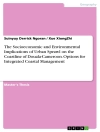This volume details the function of hydrocarbon seeps, their evolution over time, the most important seep occurrences and the fauna present in ancient hydrocarbon seeps. While several publications exist that cover modern seeps and vents, fossil seeps only constitute a small component of the literature. As such, many geologists, stratigraphers and paleontologists, as well as undergraduates and graduate students, are not very familiar with ancient hydrocarbon seep deposits and their associated fauna. This text is the first to comprehensively discuss the nature of such animal groups and how to recognize them. In addition to summarizing available knowledge on these topics for specialists in the field, this book offers the background needed to be of use to students as well as the wider community of geologists and paleontologists.
Jadual kandungan
Chapter 1-Introduction.- Chapter 2-Biogeochemical processes.- Chapter 3-Taphonomy and diagenesis of seeps.- Chapter 4-Biota.- Chapter 5-Seeps around the world.- Chapter 6-Seeps as ecosystems.- Chapter 7-Evolution of seep communities over geological time.- Chapter 8-Cognate communities.
Mengenai Pengarang
Dr. Andrzej Kaim is Associate Professor at the Institute of Paleobiology, Polish Academy of Sciences, Poland. His research interests include the early ontogeny and phylogeny of mollusks, in particular gastropods, and the recovery and paleodiversity patterns of benthic marine faunas after the Permian-Triassic extinction event. In the last 25 years he has worked on the origin and evolution of chemoautotrophic communities studying material from a variety of ancient hydrocarbon seeps, ranging from the Arctic to the Antarctic and the U.S. Pacific Coast to Japan.
Dr. J. Kirk Cochran is Distinguished Professor Emeritus at the School of Marine and Atmospheric Sciences, Stony Brook University, New York. His research interests include the use of isotope systems as tracers for processes in modern aquatic environments, including the coastal and open ocean, lakes, rivers and groundwater. He has also used isotope geochemistry as a tool for deciphering ancient marine environments, including the Western Interior Seaway of North America and hydrocarbon seeps.
Dr. Neil H. Landman is Curator Emeritus in the Division of Paleontology at the American Museum of Natural History, New York. His interests include the evolution of externally shelled cephalopods, especially ammonites, the Cretaceous/Paleogene boundary event, and the Upper Cretaceous Western Interior of North America. In the last 20 years, he has worked together with colleagues and students to study ancient hydrocarbon seeps.












